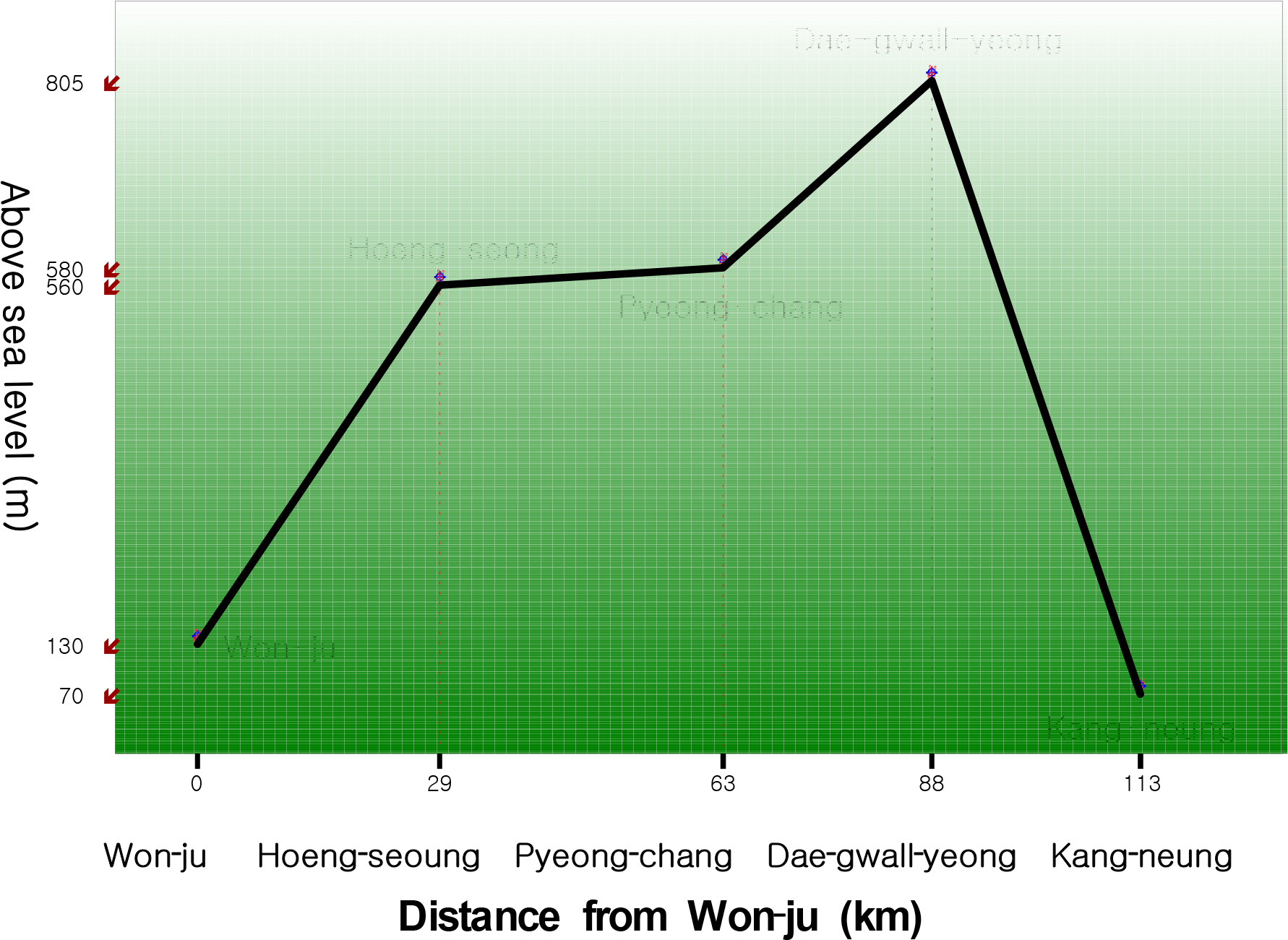J Korean Ophthalmol Soc.
2008 May;49(5):825-830. 10.3341/jkos.2008.49.5.825.
Intraocular Pressure Change in Rabbits with Intraocular Gas During Ascending Car Travel
- Affiliations
-
- 1Department of Ophthalmology, Wonju Christian Hospital, Yonsei University, Wonju College of Medicine, Wonju, Korea. bswhitey@yonsei.ac.kr
- KMID: 2211714
- DOI: http://doi.org/10.3341/jkos.2008.49.5.825
Abstract
-
PURPOSE: The authors studied the change according to altitude in the intraocular pressure (IOP) of rabbit models after intravitreal gas injection.
METHODS
We injected C3F8 gas (pure gas, 0.4 cc) into the vitreous cavity in six pairs of rabbits. The six rabbits were divided into the Fast group and the Slow group. After 3 days, we measured the rabbits' IOPs at five different check points along the Young-Dong Expressway while traveling in a car.
RESULTS
The IOPs of the Fast and the Slow groups at each check point, respectively, were 11.83+/-2.14, 13.00+/-3.69 (p=0.518) in Won-ju (130 m), 20.00+/-2.28, 21.17+/-2.14 (p=0.382) in Hoeng-seong (560 m), 28.00+/-2.60, 24.83+/-1.94 (p=0.038) in Pyeong-chang (580 m), 30.83+/-3.60, 26.67+/-1.63 (p=0.027) in Dae-gwall-yeong (805 m) and 9.83+/-1.17, 10.83+/-2.14 (p=0.338) in Kang-neung (70 m). We found that IOP increased with increased altitude in both groups. The IOP of the Fast group was significantly higher than that of the Slow group at the Pyeong-chang and Dae-gwall-yeong check points.
CONCLUSIONS
We observed that IOP increased during car travel as altitude increased. In addition, we found that the rate of ascent was a risk factor for increased IOP. Therefore, it is important to inform patients with intraocular gas to avoid fast ascents during car travel and to ascend slowly after IOP has stabilized.
Keyword
Figure
Reference
-
References
1. Brinkley JR. Flying after vitreous injection. Am J Ophthalmol. 1980; 90:580.
Article2. Fuller D. Flying and intraocular gas bubble. Am J Ophthalmol. 1981; 91:276–7.3. Stinson TW III, Donlon JV Jr. Interaction of intraocular air and sulfur hexafluoride with nitrous oxide: a computer simulation. Anesthesiology. 1982; 56:385–8.4. Norton EW, Fuller DG. advances in Vitreous Surgery. 1st ed.Springfield, III: Charles C Thomas;1976. p. 312–25.5. Sabates WI, Abrams GW, Swanson DE, Norton EW. The use of intraocular gases; the results of sulfur hexafluoride gas in retinal detachment surgery. Ophthalmology. 1981; 88:447–54.6. Crittenden JJ, de Juan E Jr, Tiedeman J. Expansion of long-acting gas bubbles for intraocular use: principles and practice. Arch Ophthalmol. 1985; 103:831–4.7. Lincoff H, Weinberger D, Reppucci V, Lincoff A. Air travel with intraocular gas: I. The mechanisms for compensation. Arch Ophthamol. 1989; 107:902–6.8. Lincoff H, Weinberger D, Stergiu P. Air travel with intraocular gas: II. Clinical considerations. Arch Ophthalmol. 1989; 107:907–10.9. Hanscom TA, Diddie KR. Mountain travel and intraocular gas bubbles. Am J Ophthamol. 1987; 104:546.
Article10. Gandorfer A, Kampik A. Expansion of intraocular gas due to reduced atmospheric pressure. Case report and review of the literature. Ophthalmologe. 2000; 97:367–70.11. Shiramizu KM, Okada AA, Hirakata A. Transient amaurosis associated with intraocular gas during ascending high speed train travel. Retina. 2001; 21:528–9.12. Dieckert JP, O'Connor PS, Schacklett DE, et al. Air travel and intraocular gas. Ophthalmology. 1986; 93:642–5.13. Michael DM, Rober GD, Wai-Ching L, et al. An assessment of intraocular pressure rise in patients with gas filled eyes during simulated air flight. Ophthamology. 2001; 108:40–4.14. Gregg TK, Malcolm RI. Intraocular gas and low altitude air flight. Retina. 1994; 14:356–8.
- Full Text Links
- Actions
-
Cited
- CITED
-
- Close
- Share
- Similar articles
-
- Intraocular Pressure Changes After Gas Injection into the Rabbit Vitreous Cavity
- The Absorption of Intraocular Gas and Its Relationship with IOP
- The Absorption of Intraocular Gas and Its Relationship with IOP
- Intraocular Pressure Changes After Gas Tamponade
- The Effect of Chloral Hydrate on Intraocular Pressure in Rabbit Eye



